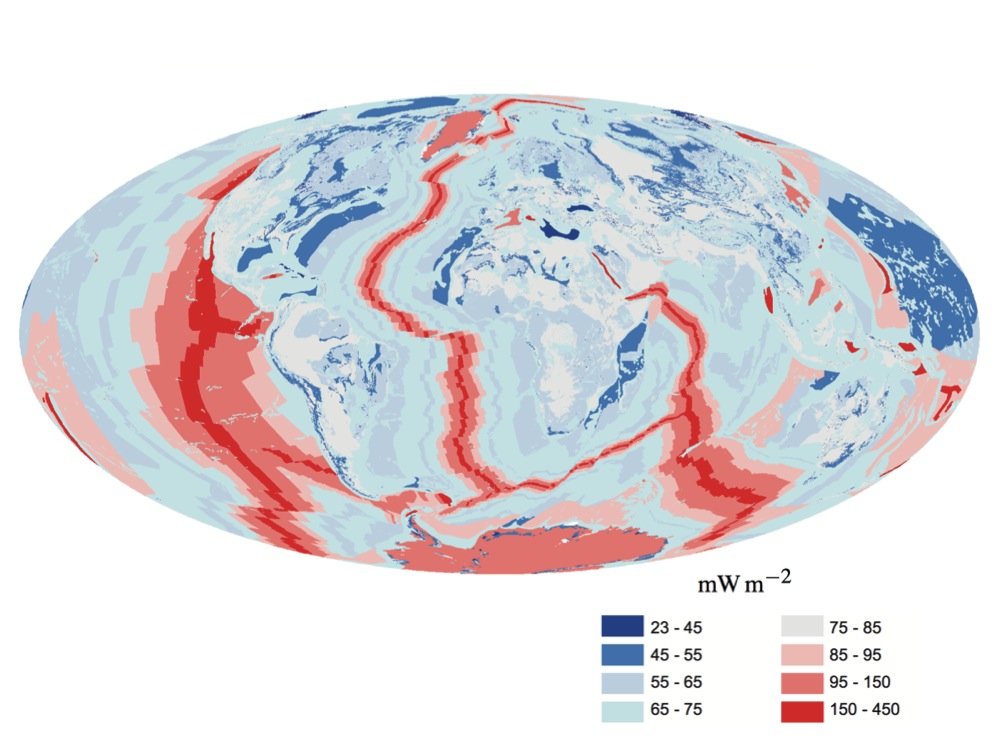|
Geotherm
Geothermal gradient is the rate of temperature change with respect to increasing depth in Earth's interior. As a general rule, the crust temperature rises with depth due to the heat flow from the much hotter mantle; away from tectonic plate boundaries, temperature rises in about 25–30 °C/km (72–87 °F/mi) of depth near the surface in most of the world. However, in some cases the temperature may drop with increasing depth, especially near the surface, a phenomenon known as ''inverse'' or ''negative'' geothermal gradient. The effects of weather, sun, and season only reach a depth of approximately 10-20 metres. Strictly speaking, ''geo''-thermal necessarily refers to Earth but the concept may be applied to other planets. In SI units, the geothermal gradient is expressed as °C/km, K/km, or mK/m. These are all equivalent. Earth's internal heat comes from a combination of residual heat from planetary accretion, heat produced through radioactive decay, latent heat f ... [...More Info...] [...Related Items...] OR: [Wikipedia] [Google] [Baidu] |
Ground-source Heat Pumps
A ground source heat pump (also geothermal heat pump) is a heating/cooling system for buildings that uses a type of heat pump to transfer heat to or from the ground, taking advantage of the relative constancy of temperatures of the earth through the seasons. Ground source heat pumps (GSHPs) – or geothermal heat pumps (GHP) as they are commonly termed in North America – are among the most energy-efficient technologies for providing HVAC and water heating, using far less energy than can be achieved by burning a fuel in a boiler/furnace or by use of resistive electric heaters. Efficiency is given as a coefficient of performance (CoP) which is typically in the range 3 – 6, meaning that the devices provide 3 – 6 units of heat for each unit of electricity used. Setup costs are higher than for other heating systems due to the requirement to install ground loops over large areas or drill bore holes, and for this reason air source heat pumps are often used instead. Thermal proper ... [...More Info...] [...Related Items...] OR: [Wikipedia] [Google] [Baidu] |
Earth's Mantle
Earth's mantle is a layer of silicate rock between the crust and the outer core. It has a mass of 4.01 × 1024 kg and thus makes up 67% of the mass of Earth. It has a thickness of making up about 84% of Earth's volume. It is predominantly solid but, on geologic time scales, it behaves as a viscous fluid, sometimes described as having the consistency of caramel. Partial melting of the mantle at mid-ocean ridges produces oceanic crust, and partial melting of the mantle at subduction zones produces continental crust. Structure Rheology Earth's mantle is divided into two major rheological layers: the rigid lithosphere comprising the uppermost mantle, and the more ductile asthenosphere, separated by the lithosphere-asthenosphere boundary. Lithosphere underlying ocean crust has a thickness of around 100 km, whereas lithosphere underlying continental crust generally has a thickness of 150–200 km. The lithosphere and overlying crust make up tectonic plates, which mov ... [...More Info...] [...Related Items...] OR: [Wikipedia] [Google] [Baidu] |
Earth's Internal Heat Budget
Earth's internal heat budget is fundamental to the thermal history of the Earth. The flow of heat from Earth's interior to the surface is estimated at 47±2 terawatts (TW)Davies, J. H., & Davies, D. R. (2010). Earth's surface heat flux. Solid Earth, 1(1), 5–24. and comes from two main sources in roughly equal amounts: the ''radiogenic heat'' produced by the radioactive decay of isotopes in the mantle and crust, and the ''primordial heat'' left over from the formation of Earth. Earth's internal heat travels along geothermal gradients and powers most geological processes. It drives mantle convection, plate tectonics, mountain building, rock metamorphism, and volcanism. Convective heat transfer within the planet's high-temperature metallic core is also theorized to sustain a geodynamo which generates Earth's magnetic field. Despite its geological significance, Earth's interior heat contributes only 0.03% of Earth's total energy budget at the surface, which is dominated by 1 ... [...More Info...] [...Related Items...] OR: [Wikipedia] [Google] [Baidu] |
Komatiites
Komatiite () is a type of ultramafic mantle-derived volcanic rock defined as having crystallised from a lava of at least 18 wt% MgO. Komatiites have low silicon, potassium and aluminium, and high to extremely high magnesium content. Komatiite was named for its type locality along the Komati River in South Africa, and frequently displays spinifex texture composed of large dendritic plates of olivine and pyroxene. Komatiites are rare rocks; almost all komatiites were formed during the Archaean Eon (4.0–2.5 billion years ago), with few younger (Proterozoic or Phanerozoic) examples known. This restriction in age is thought to be due to cooling of the mantle, which may have been hotter during the Archaean. The early Earth had much higher heat production, due to the residual heat from planetary accretion, as well as the greater abundance of radioactive isotopes, particularly shorter lived ones like uranium 235 which produce more decay heat. Lower temperature mantle melts such as ... [...More Info...] [...Related Items...] OR: [Wikipedia] [Google] [Baidu] |
Temperature Schematic Of Inner Earth
Temperature is a physical quantity that expresses quantitatively the perceptions of hotness and coldness. Temperature is measured with a thermometer. Thermometers are calibrated in various temperature scales that historically have relied on various reference points and thermometric substances for definition. The most common scales are the Celsius scale with the unit symbol °C (formerly called ''centigrade''), the Fahrenheit scale (°F), and the Kelvin scale (K), the latter being used predominantly for scientific purposes. The kelvin is one of the seven base units in the International System of Units (SI). Absolute zero, i.e., zero kelvin or −273.15 °C, is the lowest point in the thermodynamic temperature scale. Experimentally, it can be approached very closely but not actually reached, as recognized in the third law of thermodynamics. It would be impossible to extract energy as heat from a body at that temperature. Temperature is important in all fields of natural ... [...More Info...] [...Related Items...] OR: [Wikipedia] [Google] [Baidu] |
Kelvin
The kelvin, symbol K, is the primary unit of temperature in the International System of Units (SI), used alongside its prefixed forms and the degree Celsius. It is named after the Belfast-born and University of Glasgow-based engineer and physicist William Thomson, 1st Baron Kelvin (1824–1907). The Kelvin scale is an absolute thermodynamic temperature scale, meaning it uses absolute zero as its null (zero) point. Historically, the Kelvin scale was developed by shifting the starting point of the much-older Celsius scale down from the melting point of water to absolute zero, and its increments still closely approximate the historic definition of a degree Celsius, but since 2019 the scale has been defined by fixing the Boltzmann constant to be exactly . Hence, one kelvin is equal to a change in the thermodynamic temperature that results in a change of thermal energy by . The temperature in degree Celsius is now defined as the temperature in kelvins minus 273.15, meaning t ... [...More Info...] [...Related Items...] OR: [Wikipedia] [Google] [Baidu] |
Mean Average
In mathematics and statistics, the arithmetic mean ( ) or arithmetic average, or just the ''mean'' or the ''average'' (when the context is clear), is the sum of a collection of numbers divided by the count of numbers in the collection. The collection is often a set of results of an experiment or an observational study, or frequently a set of results from a survey. The term "arithmetic mean" is preferred in some contexts in mathematics and statistics, because it helps distinguish it from other means, such as the geometric mean and the harmonic mean. In addition to mathematics and statistics, the arithmetic mean is used frequently in many diverse fields such as economics, anthropology and history, and it is used in almost every academic field to some extent. For example, per capita income is the arithmetic average income of a nation's population. While the arithmetic mean is often used to report central tendencies, it is not a robust statistic, meaning that it is greatly influenc ... [...More Info...] [...Related Items...] OR: [Wikipedia] [Google] [Baidu] |
Gravitational Energy
Gravitational energy or gravitational potential energy is the potential energy a massive object has in relation to another massive object due to gravity. It is the potential energy associated with the gravitational field, which is released (converted into kinetic energy) when the objects fall towards each other. Gravitational potential energy increases when two objects are brought further apart. For two pairwise interacting point particles, the gravitational potential energy U is given by U = -\frac, where M and m are the masses of the two particles, R is the distance between them, and G is the gravitational constant. Close to the Earth's surface, the gravitational field is approximately constant, and the gravitational potential energy of an object reduces to U = mgh where m is the object's mass, g = / is the gravity of Earth, and h is the height of the object's center of mass above a chosen reference level. Newtonian mechanics In classical mechanics, two or more masses alw ... [...More Info...] [...Related Items...] OR: [Wikipedia] [Google] [Baidu] |
Carnegie Institution Of Washington
The Carnegie Institution of Washington (the organization's legal name), known also for public purposes as the Carnegie Institution for Science (CIS), is an organization in the United States established to fund and perform scientific research. The institution is headquartered in Washington, D.C. , the Institution's endowment was valued at $926.9 million. In 2018 the expenses for scientific programs and administration were $96.6 million. Eric Isaacs is president of the institution. Name More than 20 independent organizations were established through the philanthropy of Andrew Carnegie and now feature his surname. They perform work involving topics as diverse as art, education, international affairs, world peace, and scientific research. In 2007, the Carnegie Institution of Washington adopted the public name "Carnegie Institution for Science" to distinguish itself from other organizations established by and named for Andrew Carnegie. The Institution remains officially and legall ... [...More Info...] [...Related Items...] OR: [Wikipedia] [Google] [Baidu] |
1 E31 J
This list compares various energies in joules (J), organized by order of magnitude. Below 1 J 1 to 105 J 106 to 1011 J 1012 to 1017 J 1018 to 1023 J Over 1023 J } , - , 1050 , , ≳1050 J , Upper limit of 'apparent'/isotropic energy ''(Eiso)'' of Population III stars Gamma-Ray Bursts (GRBs). , - , rowspan="2" , 1053 , , >1053 J , Mechanical energy of very energetic so-called "quasar tsunamis" , - , , , 6×1053J , , Total mechanical energy or enthalpy in the powerful AGN outburst in the RBS 797 , - , 1054 , , , 3×1054J , , Total mechanical energy or enthalpy in the powerful AGN outburst in the Hercules A (3C 348) , - , 1055 , , , , >1055J , , Total mechanical energy or enthalpy in the powerful AGN outburst in the MS 0735.6+7421, Ophiucus Supercluster Explosion and supermassive black holes mergings , - , rowspan="2" , 1057 , rowspan="2" , , ~1057 J , Estimated rotational energy of M87 SMBH and total energy of the most luminous qua ... [...More Info...] [...Related Items...] OR: [Wikipedia] [Google] [Baidu] |





